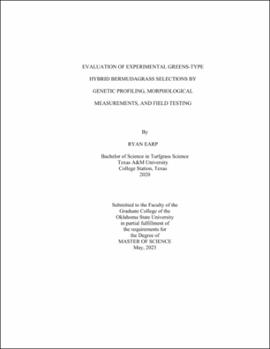| dc.contributor.advisor | Wu, Yanqi | |
| dc.contributor.author | Earp, Ryan | |
| dc.date.accessioned | 2023-08-25T20:05:55Z | |
| dc.date.available | 2023-08-25T20:05:55Z | |
| dc.date.issued | 2023-05 | |
| dc.identifier.uri | https://hdl.handle.net/11244/338908 | |
| dc.description.abstract | The lack of genetic diversity among ultradwarf bermudagrasses [Cynodon dactylon (L.) Pers. x C. transvaalensis Burtt-Davy] used throughout the southern region and transition zone in the United States is well known. To find genotypes with improvements in areas where ultradwarfs are generally lacking, new genetics must be introduced through traditional crosses. Oklahoma State University has developed multiple genotypes from cold-hardy parent materials for use as putting green surfaces. This research was conducted to quantify the genetic and morphological diversity among these new genotypes and ultradwarf cultivars for comparison, as well as evaluate the performance of these genotypes under putting green management. An additional objective of this research was to evaluate the performance of vegetation indices collected by unmanned aerial systems to estimate the percent canopy coverage of advanced phenotyping trials during and after establishment. Results showed there was significant genetic diversity between the new genotypes and the ultradwarf cultivars, while the latter showed very high genetic similarity to one another. Additionally, there was a significant difference among the morphological characteristics measured in this study in both the field and greenhouse trials. While the new genotypes were genetically distinct from the ultradwarfs, some showed similar morphological characteristics. The putting green field trial showed none of the new genotypes demonstrated similar ball roll distance to standard ‘TifEagle’, but several genotypes including OKC0920, OKC3920, 11x2, 19x19, and MSB1050 demonstrated similar or improved visual characteristics and rooting depth. A significant relationship between leaf blade length and ball roll distance for the genotypes used in this study was found which could assist breeders in making future selections. For the remote sensing methods, there was a significant relationship present between each of the methods and the logit transformed percent green cover. However, there was a significant difference between the two establishment periods. These indices may be best suited for use on their own and not estimation of percent green cover. Information collected in this research may assist in the introduction of new genotypes for use on putting green surfaces. | |
| dc.format | application/pdf | |
| dc.language | en_US | |
| dc.rights | Copyright is held by the author who has granted the Oklahoma State University Library the non-exclusive right to share this material in its institutional repository. Contact Digital Library Services at lib-dls@okstate.edu or 405-744-9161 for the permission policy on the use, reproduction or distribution of this material. | |
| dc.title | Evaluation of experimental greens-type hybrid bermudagrass selections by genetic profiling, morphological measurements, and field testing | |
| dc.contributor.committeeMember | Moss, Justin Quetone | |
| dc.contributor.committeeMember | Anderson, Michael M | |
| osu.filename | Earp_okstate_0664M_18033.pdf | |
| osu.accesstype | Open Access | |
| dc.type.genre | Thesis | |
| dc.type.material | Text | |
| dc.subject.keywords | bermudagrass | |
| dc.subject.keywords | genetic variation | |
| dc.subject.keywords | putting green | |
| dc.subject.keywords | SSR | |
| dc.subject.keywords | turfgrass | |
| dc.subject.keywords | UAV | |
| thesis.degree.discipline | Plant and Soil Sciences | |
| thesis.degree.grantor | Oklahoma State University | |
